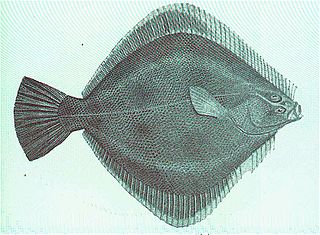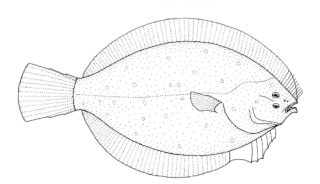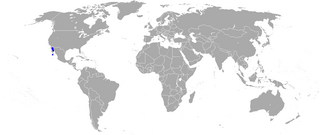
Flounders are a group of flatfish species. They are demersal fish, found at the bottom of oceans around the world; some species will also enter estuaries.

A flatfish is a member of the ray-finned demersal fish order Pleuronectiformes, also called the Heterosomata, sometimes classified as a suborder of Perciformes. In many species, both eyes lie on one side of the head, one or the other migrating through or around the head during development. Some species face their left sides upward, some face their right sides upward, and others face either side upward.

Pleuronectidae, also known as righteye flounders, are a family of flounders. They are called "righteye flounders" because most species lie on the sea bottom on their left sides, with both eyes on their right sides. The Paralichthyidae are the opposite, with their eyes on the left side. A small number of species in Pleuronectidae can also have their eyes on the left side, notably the members of the genus Platichthys.

The black flounder, also known by the Māori language name mohoao, is a species of flatfish in the family Rhombosoleidae, found around New Zealand in shallow enclosed waters and coastal freshwater lakes. Its adult length ranges from 20 to 45 cm.

The yellowbelly flounder is a flatfish of the genus Rhombosolea, found around New Zealand. A different species from the genus Rhombosolea is found in Australia and also goes by the name yellow-belly flounder. The Māori people have commonly fished for R. leporina, and many other species of flatfish, throughout New Zealand's coastal waters for hundreds of years. The Māori name for this species is pātiki tōtara.

The greenback flounder is a righteye flounder of the genus Rhombosolea, found around southern Australia and New Zealand.

The New Zealand sand flounder is a righteye flounder of the genus Rhombosolea, found around New Zealand in shallow waters down to depths of 100 m.

The New Zealand turbot, Colistium nudipinnis, is a righteye flounder of the subfamily Rhombosoleinae in the family Pleuronectidae, found around New Zealand in shallow enclosed waters.

The winter flounder, also known as the black back, is a right-eyed ("dextral") flatfish of the family Pleuronectidae. It is native to coastal waters of the western north Atlantic coast, from Labrador, Canada to Georgia, United States, although it is less common south of Delaware Bay. It is the most common near-shore (shallow-water) flounder in the waters from Newfoundland down through Massachusetts Bay, reaching a maximum size around 61 cm in length and 2.25 kg in weight. The species grows larger on Georges Bank, where they can reach a length of 70 cm and weight of 3.6 kg. Although winter flounder historically supported large commercial and recreational fisheries, biomass and landings have decreased since the 1980s.

Peltorhamphus tenuis is a righteye flounder of the family Pleuronectidae, found only around New Zealand in enclosed waters less than 100 m in depth.

The speckled sole, Peltorhamphus latus, is a righteye flounder of the family Pleuronectidae, found around New Zealand and Norfolk Island in enclosed waters less than 55 m in depth. Their length is up to 17 cm.

The yellowtail flounder, also known as the rusty dab, is a species of flatfish in the family Pleuronectidae. Reaching 56 cm (22 in) in length, it has reddish brown upperparts, pale underparts and yellow fins. Both its eyes are on the right (upper) side of its body. Found in the western North Atlantic, it has been fished commercially by North American fisheries for food. A victim of overfishing, the yellowtail flounder is categorized as "Vulnerable" by the International Union for Conservation of Nature.

Rhombosolea is a genus of righteye flounders. The four species in this genus can be found in the waters around New Zealand and southern Australia.

Pleuronichthys is a genus of fish in the family Pleuronectidae found in the Pacific Ocean.

The Remo flounder, Oncopterus darwinii, is an edible flatfish of the family Pleuronectidae. It is a demersal fish that lives on bottoms at depths of between 20 and 80 metres. Its native habitat is the southwestern Atlantic along the southeast coast of South America, from Santa Catarina, Brazil in the north to the San Matías Gulf, Argentina in the south. It can reach 30 centimetres (12 in) in length.

The Indonesian ocellated flounder, Psammodiscus ocellatus, is an edible flatfish of the family Pleuronectidae. It is a demersal fish that lives on sandy bottoms in the eastern Indian Ocean, particularly Indonesia and northwestern Australia. It can reach 15 centimetres (5.9 in) in length.

The Poecilopsettidae are a family of flatfish, comprising three genera and 21 species. Species are typically demersal, living on marine bottoms at depths between 60 and 500 m in the Indo-Pacific and northwestern Atlantic; the deepest recorded occurrence is 1,636 m (5,367 ft) in the deepwater dab, Poecilopsetta beanii. Sizes range from 9 to 19 cm in length, though most species are usually under 15 cm (5.9 in) long. Diets consist of zoobenthos.

The ocellated turbot is a species of flatfish in the family Pleuronectidae. It is a demersal fish that lives on bottoms at depths of between 1 and 140 metres. Its native habitat is the subtropical waters of the eastern Pacific, specifically southern Baja California and the upper Gulf of California ; it is the only member of the genus to prefer subtropical waters. It can grow up to 24 centimetres (9.4 in) in length.
The large-scale righteye flounder is a flatfish of the family Pleuronectidae. It is a demersal fish that lives on saltwater bottoms at depths of between 108 and 180 metres. Its natural habitat is the tropical waters of the Indo-West Pacific, from Bali to Indonesia and the southwest coast of India. It can grow up to 9 centimetres (3.5 in) in length.

The eyed flounder is a species of fish in the family Bothidae. The species is found on or near the sandy seabed in relatively shallow waters in the western Atlantic Ocean, the Caribbean Sea and the Gulf of Mexico.



















